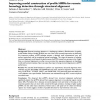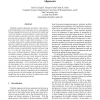820 search results - page 2 / 164 » Using Multiple Alignments to Improve Gene Prediction |
BMCBI
2007
13 years 5 months ago
2007
Background: Remote homology detection is a challenging problem in Bioinformatics. Arguably, profile Hidden Markov Models (pHMMs) are one of the most successful approaches in addre...
BMCBI
2004
13 years 5 months ago
2004
Background: Many current gene prediction methods use only one model to represent proteincoding regions in a genome, and so are less likely to predict the location of genes that ha...
BMCBI
2005
13 years 5 months ago
2005
Background: Alignments of homologous DNA sequences are crucial for comparative genomics and phylogenetic analysis. However, multiple alignment represents a computationally difficu...
BMCBI
2008
13 years 5 months ago
2008
Background: Structural alignment of RNAs is becoming important, since the discovery of functional non-coding RNAs (ncRNAs). Recent studies, mainly based on various approximations ...
SSDBM
2006
IEEE
13 years 11 months ago
2006
IEEE
Multiple sequence alignment represents a class of powerful bioinformatics tools with many uses in computational biology ranging from discovery of characteristic motifs and conserv...


